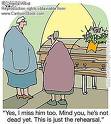 A singer friend of mine currently residing in Asia but normally based in Los Angeles, Titus Levi, forwarded me an email he received from the composer/pianist Gene Carl. Titus had asked Gene what makes writing for voice and chorus so tricky. Gene’s response was so thoughtful that I asked if I could publish his musings as a guest blog here at lies like truth. Gene generously agreed. Here’s what the composer has to say on the subject:
A singer friend of mine currently residing in Asia but normally based in Los Angeles, Titus Levi, forwarded me an email he received from the composer/pianist Gene Carl. Titus had asked Gene what makes writing for voice and chorus so tricky. Gene’s response was so thoughtful that I asked if I could publish his musings as a guest blog here at lies like truth. Gene generously agreed. Here’s what the composer has to say on the subject:
Text, small ambitus, rests and the melodic line. Basically. Nadia Boulanger, the teacher who taught Stravinsky’s way of composition to among others, Copland, Carter and Thomson, made her students study the final cadences in the Chorals–unbelieveable how varied. Carter’s account of those lessons was inspiring to me.
With words a composer has to remember which vowels can be sung easily high and low. It’s not forbidden to do the opposite, but singers are very suspicious if they see parts which don’t follow the “rules”. Pink Chinese Restaurants has four songs which form the trunk of the cantata. Everyone says the first song Sun Luck is the best written for voice. The last piece is supposed to be “awkward” cause there’s lots of “i’s” in the highest notes. I think of the problems with West Side Story, also. The minor 7th rise in “there’s a place for us”, or the rhythmic syncopation and change of meter in “Something’s coming” which Jose Carrera proved was VERY difficult in the documentary about the recording of West Side Story with opera singers: Bernstein got furious and called a pause.
Also, the voice is not conducive to large leaps especially downwards. Stepwise is what one’s taught–jumps are seldom used and never in succession. Everytime I write a descending minor 6th I get a lecture from a vocalist. And then the constant use of the descending tritone in Ifigeneia’s final chorus caused innumerable comments—but sounded incredible.
Also, the ambitus is usually smaller and the use of lots of highs continuously leads to aspiration–los of voice! Have heard it happen.Duke Ellington is one of the only composers I can think of who uses as few notes as possible for each instrument–almost choral writing for Band.
Think of the problems if the soprano is more than 2 octaves distance from the bass. Watch how the soprano relates to the bass–that’s the clue of good writing too whether its close or open harmony.
The rise of instrumental music, and dance music outside of the church music, freed up a lot of composers so they could both write quicker music and not be so concerned with intervals, as long as it was able to be fingered without too much problem.
When I took a workshop on Mongolian throat singing (singing harmonics through focusing and shaping the mouth cavity which I first heard on recordings from Tuva which Richard Feynman was crazy about–you remember the stoned Physics prof at Cal Tech who got TWO Nobel prizes). The teacher gave me a big lecture on the “place” of the vowels and consonants in the mouth and gave me a diagram of this.
For some reason the “latin” countries (Italy, Spain and France) have a greater tradition in singing. Trouveres, troubadores, the first polyphonic music fauxbourdon, Notre Dame School, Hocket technique, Perotin and Leonin, and other developments seem to have preceeded the Minnesangers and other Germanic vocal developments where folk singing was much more important. The English have their own development which often paralelled the continent and especially when composers went to study there or composers from the continent came to English courts. Wonderful history, actually.
The development of polyphonic music hinges on an understanding of how different voices, starting at different moments in the musical phrase, can make sense language-wise. During the Renaissance there was a development of pieces with more than one text simultaneously which shows how composers hadn’t solved that problem and avoided it. The hyper polyphony of Ockegehm and Obrecht, and also Dufay, De la Rue—the canons which were sung with simultaneously different time signatures–are still mysterious to our ears. Kohn gave courses on the multi-rhythmic Middle Ages and Renaissance music where there were really no measures or regular “takt”. Even Bach was re-measured by Bartok in his editions of the WohlTempierte Klavier. L’homme arme changes meters and was the most used “secular” folk song of the time.
We are really square compared to that time. Listening to Pavement (Twilight) gives me a warm feeling cause they use the text and follow thatrhythm, no matter what. Yes, Monk, too. And Joni.
As for NONO: Il Canto Sospeso, is his masterwork, based on letters from camp victims of WWII. His and Dallapiccola’s works are intricate because the syllables are often divided up amongst different vocal lines–an extension and development of hocket technique, really. A word like “mag-ni-fi-cent-ly” would need five singers, one for each syllable. Very difficult to bring off and impossible to understand. PLUS: one singer sings “mag”, the next “ni” and so on—not too nice for the singers. Especially Ha venido for soprano and six sopranos is brilliant this way and a very classical choral conductor who I spoke with, expressed his respect for Nono and Dallapiccola to my shock. He said the lines and the notes which a singer has to take his/her note from are very clear. Cuando stanno morendo is also a beautiful piece where the solution is different than his earlier works. The best was one of the Operas with three Marilyn Monroe’s singing together in intricate polyphony–the name of the Opera eludes me. I saw it once in Holland Festival–70’s.
About guest blogger Gene Carl:
Gene Carl (1953 Burbank, California) pianist/composer received awards as a young pianist finishing his BA cum laude at Pomona College in ʼ75 and was awarded the Thomas J. Watson Fellowship. At the Royal Conservatory in The Hague he was awarded the Prize of Composition in ʼ83 and in the same year got an award from ElectroMusic Competition in Bourges, France. He toured with Andiressenʼs group Hoketus, with other ensembles and solo including Cageʼs Sonatas and Interludes”. As well heʼs produced/arranged in projects around Brian Wilson and Joni Mitchell. His last composition project was with Robert Woodruff and Toneelgroep Amsterdam for “Iphigeneia in Aulis”. He wrote many articles about Dutch music most notably about the composer/philosopher Dick Raaijmakers, and was guest editor for the dubble issue on Schoenberg in The Netherlands. At the moment heʼs working on a chamber opera based on Tournierʼs The Golden Droplet scheduled for the Chamber Opera Festival in 2011. He has 7 CDʼs and 2 LPʼs out with his own work and is pianist/synthesizer player on othersʼ LPʼs/CDʼs.

 Having complained about the snoozing audience at the Auerbach/Weilerstein gig a couple of nights ago, it was gratifying to see an audience wide awake and vociferously responsive at
Having complained about the snoozing audience at the Auerbach/Weilerstein gig a couple of nights ago, it was gratifying to see an audience wide awake and vociferously responsive at  Two things to share with you this morning:
Two things to share with you this morning: Last Friday, over lunch with a friend, the discussion turned to ways to make classical music relevant to younger audiences. This hoary topic tends to make conversation spiral around in circles. But I feel that there’s enough happening in the field these days to suggest that composers and musicians are doing what they can to reach out to younger audiences.
Last Friday, over lunch with a friend, the discussion turned to ways to make classical music relevant to younger audiences. This hoary topic tends to make conversation spiral around in circles. But I feel that there’s enough happening in the field these days to suggest that composers and musicians are doing what they can to reach out to younger audiences.  Thoughts about some stuff I did at the weekend:
Thoughts about some stuff I did at the weekend: I know rehearsal periods for theatrical productions are tight in this country. Artists manage to pull of incredible feats i four weeks through sheer hard work, talent and caffeine. But I’m getting a little tired of theater companies using preview performances as dress rehearsals.
I know rehearsal periods for theatrical productions are tight in this country. Artists manage to pull of incredible feats i four weeks through sheer hard work, talent and caffeine. But I’m getting a little tired of theater companies using preview performances as dress rehearsals. One of the most frustrating things about hosting a radio show which airs from 10 – 11 pm on a Friday night is that you get a lot of disgruntled would-be listeners writing to you to let you know that they’d love to tune in — if only the show weren’t happening at such an awkward time during the week. I’ve been getting several requests a week from people asking about whether it’s possible to hear the show after the fact
One of the most frustrating things about hosting a radio show which airs from 10 – 11 pm on a Friday night is that you get a lot of disgruntled would-be listeners writing to you to let you know that they’d love to tune in — if only the show weren’t happening at such an awkward time during the week. I’ve been getting several requests a week from people asking about whether it’s possible to hear the show after the fact